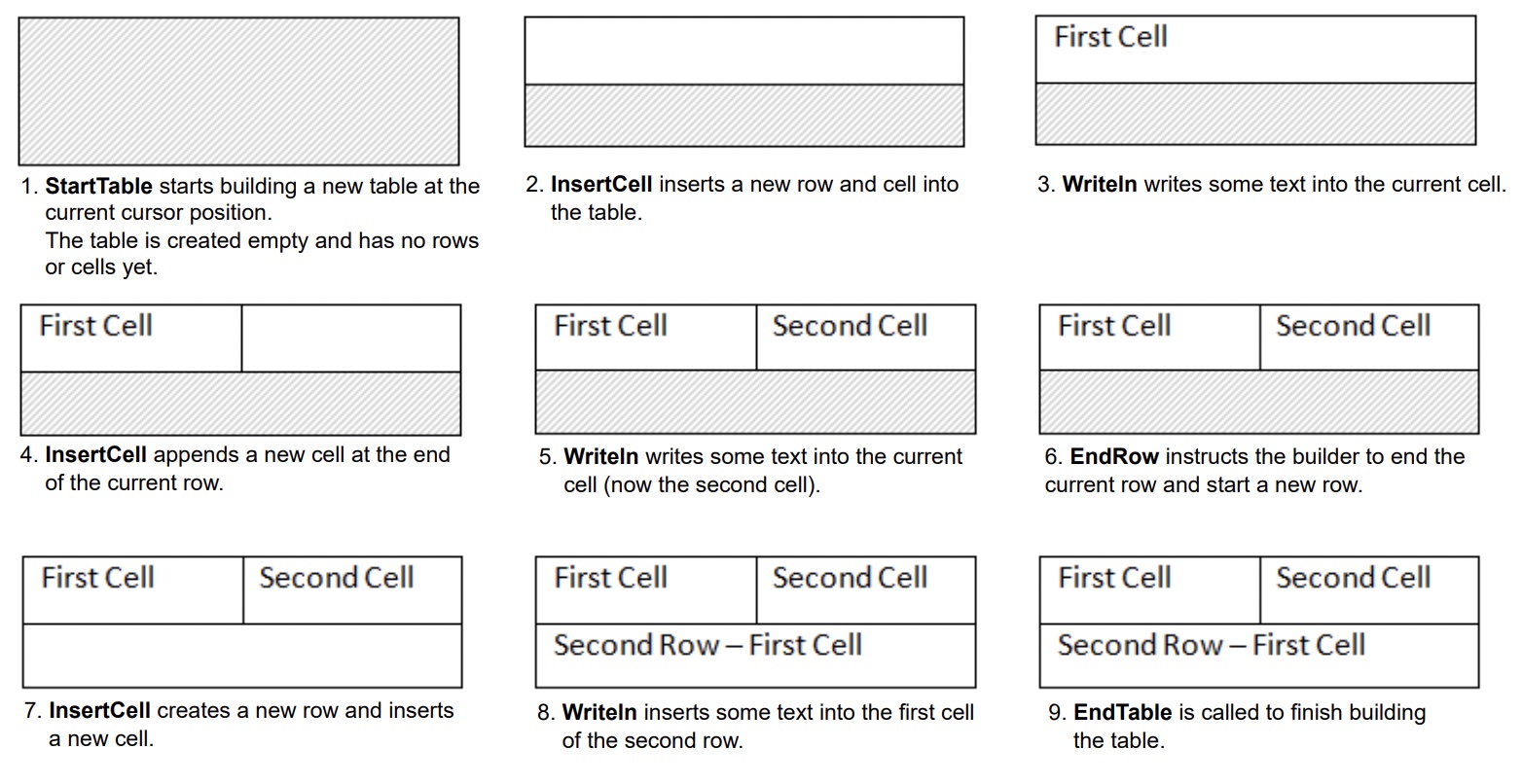Analyzing your prompt, please hold on...
An error occurred while retrieving the results. Please refresh the page and try again.
Aspose.Words permite a los usuarios crear tablas en un documento desde cero y proporciona varios métodos diferentes para hacerlo. Este artículo presenta detalles sobre cómo agregar tablas formateadas a su documento usando cada método, así como una comparación de cada método al final del artículo.
La tabla recién creada recibe valores predeterminados similares a los utilizados en Microsoft Word:
| Propiedad de tabla | Predeterminado en Aspose.Words |
|---|---|
Border Style |
Single |
Border Width |
1/2 pt |
Border Color |
Black |
Left and Right Padding |
5.4 pts |
AutoFit Mode |
AutoFit to Window |
Allow AutoFit |
True |
En Aspose.Words, los usuarios pueden crear una tabla en un documento usando DocumentBuilder. El algoritmo básico para crear una tabla es el siguiente:
Detalles importantes:
El proceso de creación de una tabla se puede ver claramente en la siguiente imagen:

El siguiente ejemplo de código muestra cómo crear una tabla simple usando DocumentBuilder con formato predeterminado:
El siguiente ejemplo de código muestra cómo crear una tabla formateada usando DocumentBuilder:
El siguiente ejemplo de código muestra cómo insertar una tabla anidada usando DocumentBuilder:
Puede insertar tablas directamente en DOM agregando un nuevo nodo Table en una posición específica.
Tenga en cuenta que inmediatamente después de la creación del nodo de la tabla, la tabla en sí estará completamente vacía, es decir, aún no contiene filas ni celdas. Para insertar filas y celdas en una tabla, agregue los nodos secundarios Row y Cell apropiados al DOM.
El siguiente ejemplo de código muestra cómo crear una nueva tabla desde cero agregando los nodos secundarios apropiados al árbol del documento:
Aspose.Words admite la inserción de contenido en un documento desde una fuente HTML utilizando el método InsertHtml. La entrada puede ser una página HTML completa o simplemente un fragmento parcial.
Con el método InsertHtml, los usuarios pueden insertar tablas en el documento mediante etiquetas de tabla como <table>, <tr>, <td>.
El siguiente ejemplo de código muestra cómo insertar una tabla en un documento a partir de una cadena que contiene etiquetas HTML:
A menudo hay ocasiones en las que es necesario crear una tabla basada en una tabla ya existente en un documento. La forma más sencilla de duplicar una tabla conservando todo el formato es clonar el nodo Tabla utilizando el método Clone.
Se puede utilizar la misma técnica para agregar copias de una fila o celda existente a una tabla.
El siguiente ejemplo de código muestra cómo duplicar una tabla utilizando constructores de nodos:
El siguiente ejemplo de código muestra cómo clonar la última fila de una tabla y agregarla a la tabla:
Si está pensando en crear tablas en un documento que crezcan dinámicamente con cada registro de su fuente de datos, no se recomienda el método anterior. En cambio, el resultado deseado se logra más fácilmente utilizando Mail merge con regiones. Puedes conocer más sobre esta técnica en la sección “Mail Merge con Regiones”.
Aspose.Words proporciona varios métodos para crear nuevas tablas en un documento. Cada método tiene sus propias ventajas y desventajas, por lo que la elección de cuál utilizar depende a menudo de la situación específica.
Echemos un vistazo más de cerca a estas formas de crear tablas y comparemos sus ventajas y desventajas:
| Método | Ventajas | Desventajas |
|---|---|---|
Vía DocumentBuilder |
El método estándar para insertar tablas y otro contenido de documentos | A veces es difícil crear muchas variedades de tablas al mismo tiempo con la misma instancia del constructor. |
| Vía DOM | Se adapta mejor al código circundante que crea e inserta nodos directamente en el DOM sin utilizar un DocumentBuilder | La tabla se crea “vacía”: antes de realizar la mayoría de las operaciones, debe llamar a EnsureMinimum para crear los nodos secundarios que faltan. |
| Desde HTML | Puede crear una nueva tabla a partir de una fuente HTML usando etiquetas como <table>, <tr>, <td> |
No todos los formatos posibles de tablas Microsoft Word se pueden aplicar a HTML |
| Clonar una tabla existente | Puede crear una copia de una tabla existente conservando todo el formato de filas y celdas. | Los nodos secundarios apropiados deben eliminarse antes de que la tabla esté lista para su uso. |
Analyzing your prompt, please hold on...
An error occurred while retrieving the results. Please refresh the page and try again.